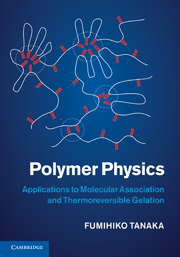Book contents
- Frontmatter
- Contents
- Preface
- 1 Statistical properties of polymer chains
- 2 Polymer solutions
- 3 Classical theory of gelation
- 4 Elasticity of polymer networks
- 5 Associating polymer solutions and thermoreversible gelation
- 6 Nongelling associating polymers
- 7 Thermoreversible gelation
- 8 Structure of polymer networks
- 9 Rheology of thermoreversible gels
- 10 Some important thermoreversible gels
- Index
- References
8 - Structure of polymer networks
Published online by Cambridge University Press: 16 May 2011
- Frontmatter
- Contents
- Preface
- 1 Statistical properties of polymer chains
- 2 Polymer solutions
- 3 Classical theory of gelation
- 4 Elasticity of polymer networks
- 5 Associating polymer solutions and thermoreversible gelation
- 6 Nongelling associating polymers
- 7 Thermoreversible gelation
- 8 Structure of polymer networks
- 9 Rheology of thermoreversible gels
- 10 Some important thermoreversible gels
- Index
- References
Summary
This chapter studies the local and global structures of polymer networks. For the local structure, we focus on the internal structure of cross-link junctions, and study how they affect the sol–gel transition. For the global structure, we focus on the topological connectivity of the network, such as cycle ranks, elastically effective chains, etc., and study how they affect the elastic properties of the networks. We then move to the self-similarity of the structures near the gel point, and derive some important scaling laws on the basis of percolation theory. Finally, we refer to the percolation in continuum media, focusing on the coexistence of gelation and phase separation in spherical colloid particles interacting with the adhesive square well potential.
Local structure of the networks–cross-linking regions
Most physical gels have complex multiple junctions. In Section 7.4, we studied thermoreversible gelation with junctions of variable multiplicity. In this section, we consider a new method to find the local structure of the networks, i.e., the structure of the network junctions.
Junction multiplicity k was defined by the number of chains connected to a single junction. Simple pairwise cross-links, for example, have multiplicity k = 2, whose sol–gel transition is detailed in Section 7.4 and in the classical literature [1]. For networks with junctions of multiplicity larger than two, the conventional Eldridge–Ferry procedure [2] to find the enthalpy of melting, which plots the logarithm of the gelation concentration ln c* against the inverse temperature, does not work because it assumes pairwise crosslinking.
- Type
- Chapter
- Information
- Polymer PhysicsApplications to Molecular Association and Thermoreversible Gelation, pp. 247 - 280Publisher: Cambridge University PressPrint publication year: 2011



